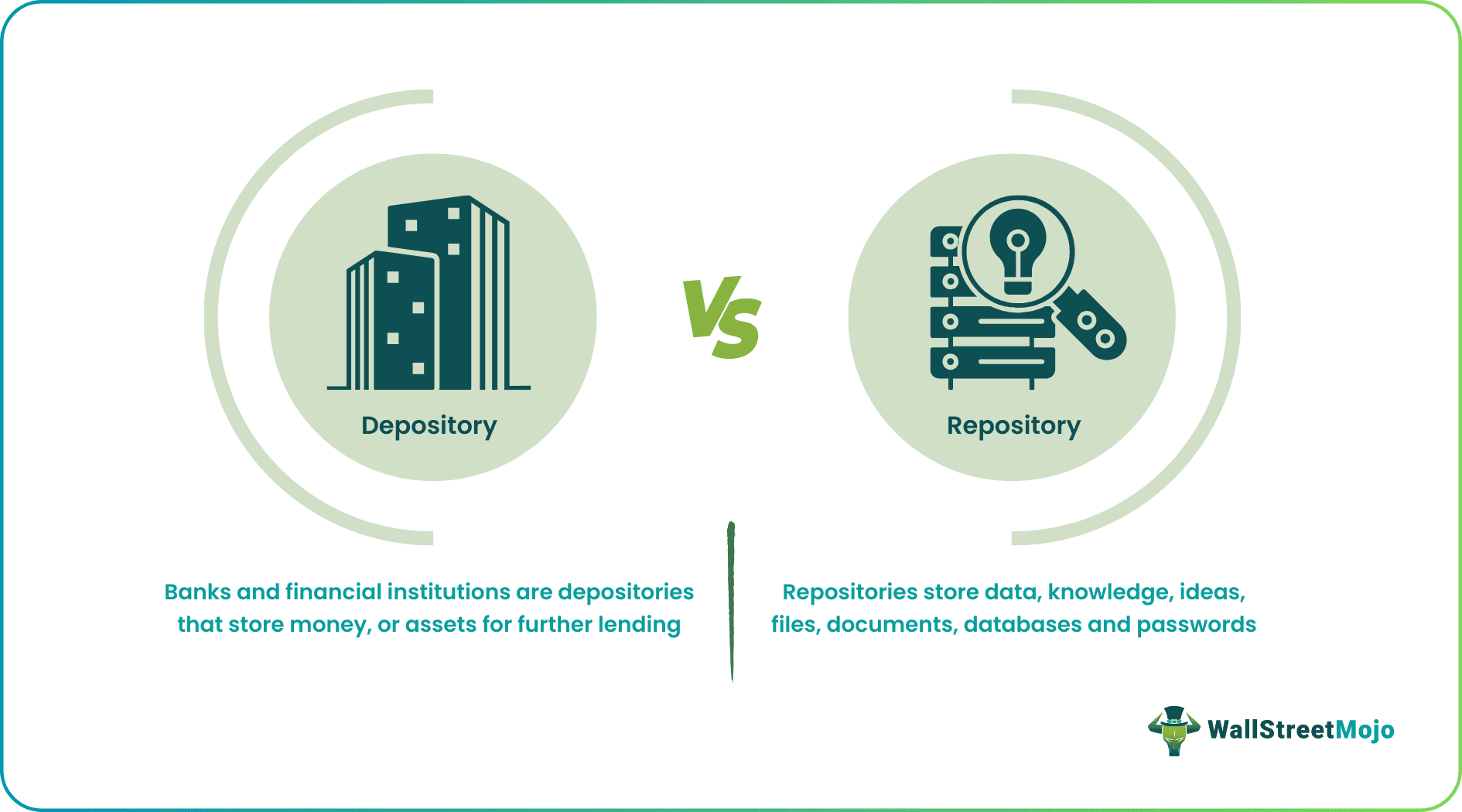Table Of Contents
Difference between Depository and Repository
A depository is a place where something is kept for security purposes or safeguarding; a repository, on the other hand, has the capacity to store information. Depositories usually hold something tangible. In contrast, a repository could hold software that stores programs and files or a website that holds a bundle of information.
Banks, organizations, and institutions where money or assets are stored for further lending are depositories. Repositories store data, knowledge, ideas, files, documents, databases, and passwords.
Depository Vs Repository Comparative Table

Let us look at a depository vs repository comparative table to understand their characteristics. The terms depository and repository mean the same for most individuals. But upon closer inspection, we notice specific differences.
A depository usually stores tangible or materialistic valuables. A repository is a virtual safe for storing information or abstract articles.
The differences between depository and repository are as follows:
| Criteria | Depsitory | Repository |
|---|---|---|
| Definition | A depository is a physical storage; an organization, bank, warehouse, or institute stores valuables—securities, assets, and money. Stored assets same can be transferred or lent to others. | A repository is an arrangement. It could be a website, software, or a book that stores abstract information—database, documents, files, ideas, programs, etc. |
| Mode of Storage | It is a physical location; an organization, office, warehouse, bank, vault, institute, or a secure building. | It can be a virtual safe–a book, software, or a website. |
| Stored Assets | It stores assets, securities, cash, etc. | It protects abstract information—knowledge, ideas, documents, data, files, programs, etc. |
| Utility | It facilitates liquidity, deposits, storage, safekeeping, lending, and transfers. | It facilitates storage, security, indexing, search, and retrieval. |
| Examples | Some of the largest American banks like Wells Fargo & Co., JPMorgan Chase & Co., and Goldman Sachs Group are depositories. | Popular software repositories include Cloudsmith, GitHub, and GitLab. |
What is Depository?
A depository is a physical location or facility where valuable things are kept for safekeeping. It could be an organization, bank, financial institution, office, institute, warehouse, safehouse, vault, or simply a building that stores valuables. The valuables are in the form of goods, securities, assets, money, and printed documents stored under the administration of a trustee.
Primarily, there are three important depositories—commercial banks, credit unions, and savings institutions. They secure investors' money or securities and provide interest on them. Moreover, depositories are required to hand over deposited valuables to owners—when demanded.
Along with security, depositories offer liquidity by facilitating the hassle-free transfer of money, goods, securities, and assets. Banks and financial institutions extend credit in lieu of the stored money or asset. Also, goods submitted for safekeeping can be conveniently transferred from one place to another. Tangible assets like money, securities, and valuables are converted into electronic forms for safety and ease of transfer. Further, it protects assets from possible fraud, theft, fire, damage, or loss.
For example, when individuals deposit their savings in a savings account with a bank, the bank acts as a depository. In such scenarios, the bank is a trustee for the funds. The bank keeps the money and makes an electronic entry in the customer's passbook. It credits the funds to the customer's savings account. The bank can then lend this money to another customer to yield interest. Also, it disburses a portion of earnings to depositors as interest.
What is a Repository?
A repository refers to a capacity or an archive where any data or abstract article is stored. In information technology, the term 'repository' is used widely. A virtual storage stores software, folders, and websites. It safeguards files, databases, programs, and secured credentials. For example, Scarlet iOS is a third-party app repository that allows iPhone and iPad users to access apps not available on the official App Store. Similarly, wallstreetmojo.com archives thousands of articles on investment banking, financial modeling, and Excel.
A repository can also be a book—writers save information for the readers to gain knowledge and ideas. A repository's major purpose is the storage and preservation of data. Users should be able to find and retrieve stored data whenever required—through techniques like data mining. Repositories are classified into subtypes—content repository, information repository, software repository, disciplinary repository, and institutional repository.
They protect information from cyber theft, malware, and viruses through a secured system—single-use credentials or antivirus. Also, when files become corrupt, they can be retrieved through a repository's backup infrastructure.
For example, wallstreetmojo.com archives thousands of articles on investment banking, financial modeling, and excel.
Depository Vs Repository Infographics

Similarities
Let us look at depository vs repository similarities. Depository and repository are both storage options—where assets are aggregated for protection or safekeeping. Also, in the English language, these terms are often used interchangeably.
However, the nature of items stored in both cases is different, and so also the purpose of safekeeping.

